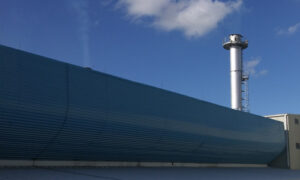What is Cross Ventilation from Moffitt?
Cross ventilation (also called Wind Effect Ventilation) is a natural method of cooling. The system relies on wind to force cool exterior air into the building through an inlet (like a wall louver, a gable, or an open window) while outlet forces warm interior air outside (through a roof vent or higher window opening). Modern natural ventilation systems help increase the flow of cool air coming in and assist the stifling air going out. This increases building air flow naturally.
Keeping Cool with Wind Effect Ventilation
Knowing how the fresh air circulates within a structure. around the people inside, and through its openings is crucial to determining how to optimize cooling and improve air quality. You can find this by looking at the building’s inlets and outlets. Wind Effect Ventilation controls the air quality inside of a building environmentally and cost-effectively.

When wind flows into the side of the building, each side of the building is hit with different amounts of pressure. The pressure changes force the air toward the lower pressure side of the building in the attempt to reach equilibrium. Ideally, having an opening on the lower pressure side allows the interior air to circulate out to the side with the lower pressure.
Wind Effect Ventilation relies on natural elements to provide a beneficial and comforting atmosphere within commercial and industrial buildings. This kind of ventilation is excellent in almost any climate and is an inexpensive method of cooling. There aren’t any operating costs, carbon emissions, nor energy consumption.
The Dynamics of Airflow Through Inlets and Outlets
A window or door’s orientation determines the amount of air flowing through space. Usually, an inlet only works if the direction of the wind flow is in the range of -45° to 45° to the surface. Leading to a total of a ninety-degree range around the opening. Placement of air vents often made with consideration of this air movement, leading to a total of the ninety-degree range around the opening.
When designing a cross effect system, consider both the inlet and outlet. The amount of heat removed from a facility is directly affected by those areas. If the inlet and outlet areas are large, then more air can travel through, meaning more heat can be removed. The effectiveness of the ventilation would be impeded if the inlet area were more significant than the outlet area. An unbalanced system would be created if the air that was coming in was higher than was going out. Preferably, an equal amount of airflow volume going into a building as exiting the building is the ideal outcome.
Tips for Cross Driven Wind Cross Ventilation
When designing a ventilation system that utilizes cross ventilation, the direction in which the window blows is the first concern. Knowing the wind direction (at various times through the day, and during the year) will determine where inlet and exhaust vents can be placed. The difference in wind pressure affects the overall ventilation within the building unless the ventilation system compensates accordingly.
Furthermore, specialized equipment can help to increase the effectiveness of a cross ventilation system. Products such as specialty wall fans can improve the movement of air across the work floor and through a building. Alternatively, non-powered options such as wall louvers and natural ventilators exploit the natural progression of air and increase air movement through space without any electricity.
Moffitt Corporation is one of the most trusted names in ventilation. Moffitt designs ventilation plans and manufactures ventilation equipment, and even installs ventilation systems. This turn-key approach provides Moffitt with a top-to-bottom experience. Get the most out of a natural ventilation system. We have been providing natural ventilation solutions to industrial and commercial facilities in the U.S. and around the world for over 60 years. So, fill out the form below to see how you can install a roof vent or other ventilation product and take advantage of cross ventilation today.
